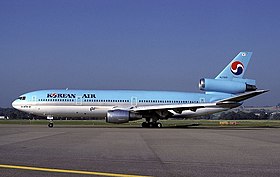Korean Air Flight 803
| Korean Air Flight 803 | |
|---|---|
|
The affected machine three years before the accident |
|
| Accident summary | |
| Accident type | Controlled flight into terrain |
| place | Suq-as-Sabt, Libya |
| date | July 27, 1989 |
| Fatalities | 75 |
| Survivors | 124 |
| Fatalities on the ground | 4th |
| Aircraft | |
| Aircraft type |
|
| operator |
|
| Mark | HL7328 |
| Departure airport |
Seoul Gimpo Airport , South Korea |
| 1. Stopover |
Don Mueang Airport , Thailand |
| 2. Stopover |
Jeddah Airport , Saudi Arabia |
| Destination airport |
Tripoli International Airport , Libya |
| Passengers | 181 |
| crew | 18th |
| Lists of aviation accidents | |
On the Korean Air Flight 803 (flight number IATA : KE803 , ICAO : KAL803 , call sign KOREAN AIR 803 ) took place on 27 July 1989, a serious air accident, when a McDonnell Douglas DC-10-30 of Korean Air for a scheduled international flight from Seoul to Tripoli was flown into the area in front of the runway at Tripoli International Airport . In the incident, 75 of the 199 occupants on board the plane and four people died on the ground. Up until the crash of a Boeing 727-200 on Libyan Arab Airlines flight 1103, it was the most serious aircraft accident in Libya.
machine
The aircraft involved in the accident was a McDonnell Douglas DC-10-30. The aircraft had the factory number 47887, it was the 125th DC-10 from ongoing production, which was finally assembled at the McDonnell Douglas plant in Long Beach , California . The machine was rolled out on September 17, 1973, and the test flight was then carried out with the test number N54643 . The DC-10 was delivered to the Thai Air Siam on November 25, 1974 , where it was put into operation with the aircraft registration HS-VGE . After the decline of the airline, the plane was on 25 February 1977 to the Korean Air Lines , which in the 1980s in Korean Air was renamed. The machine received the aircraft registration HL7328 . The three - engine long - range wide - body aircraft was equipped with three General Electric CF6-50C2 engines. The total operating performance of the machine up to the accident was 49,052 operating hours, which accounted for 11,440 take-offs and landings.
Passengers, crew and flight plan
Flight KE803 was supposed to run from Gimpo Airport near Seoul to Tripoli International Airport , with scheduled stopovers at Don Mueang Airport in Thailand and Jeddah Airport in Saudi Arabia . The captain was the 54-year-old Kim Ho-jun, the first officer was the 57-year-old Choi Jae-hong and the flight engineer was the 53-year-old Hyun Gyu-hwan. In addition to the 18 crew members, 181 passengers had taken the last leg of the flight. The majority of the passengers were South Korean construction workers who were on their way to work in Libya after a stopover in their homeland. Many of the inmates were employed by the South Korean companies Daewoo and Donga .
| nationality | Passengers | crew | total |
|---|---|---|---|
|
|
171 | 18th | 189 |
|
|
7th | - | 7th |
|
|
3 | - | 3 |
| total | 181 | 18th | 199 |
Course of the flight and course of the accident
The flight went without any abnormalities up to the approach to Tripoli. Visibility around the destination airport was poor in thick fog, visibility ranged from 100 to 800 feet (approx. 30 to 240 meters). The pilots received clearance to approach runway 27 of the airport, but air traffic control informed the pilots that the instrument landing system on this runway was out of order. The crew decided to make the approach despite these difficult weather conditions. On the final approach, the aircraft fell below the minimum descent altitude. The plane hit the ground in the Suq-as-Sabt district to the east of the airport, 2.4 kilometers from the airport. Four houses and numerous cars were hit on the ground in the 400-meter-long crash area. The hull broke into three pieces and a fire broke out. In the accident, 75 people were killed on board the machine, including 72 passengers and three crew members. Four people also died on the ground.
Accident investigation
During the investigation into the accident, the Libyan authorities worked with French investigators from the Bureau d'Enquêtes et d'Analyses pour la sécurité de l'aviation civile , as the conflict over Libyan involvement in the bombing of Pan-Am flight 103 the previous year had caused the Libyan government did not allow US citizens into the country. Accordingly, employees of the manufacturer McDonnell Douglas were not granted entry. Cooperation with the French authorities did not prevent Libyan authorities from blowing up a French passenger plane with the bombing of UTA Flight 772 under similar conditions.
The cause of the accident was determined to be the pilots' attempt to drop the aircraft below the minimum descent altitude without the runway area being in sight at this point in time. It was found that the ILS at Tripoli Airport was out of order at the time of the accident. The captain also stated that 15 minutes before the collision, contact with air traffic control had been broken off.
swell
- Accident report DC-10-30, HL7328 in the Aviation Safety Network
- Operating history of the machine on planespotters.net
- 75 The Libya in Korean DC-10 Crash , Associated Press / New York Times , Jul 28, 1989, 8.
- Tripoli's Landing System not working , Tuscaloosa News , page 2.
Individual evidence
- ↑ 75 The in Libya in Korean DC-10 Crash , The New York Times, July 28, 1989
